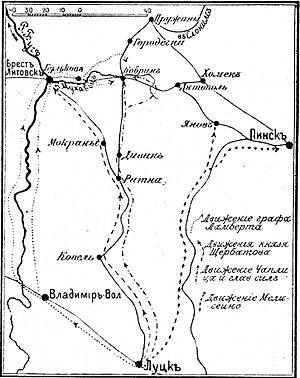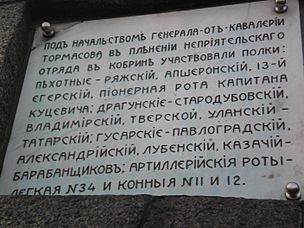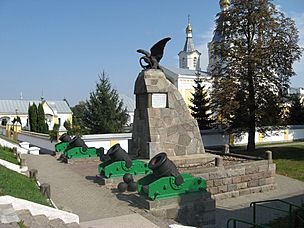Battle of Kobrin facts for kids
Quick facts for kids Battle of Kobrin (Kobryn) |
|||||||
|---|---|---|---|---|---|---|---|
| Part of the French invasion of Russia | |||||||
 Theater of military operations |
|||||||
|
|||||||
| Belligerents | |||||||
| Commanders and leaders | |||||||
| Strength | |||||||
| Third Reserve Army of Observation: 44,000 12,000 participated |
VII Corps: 15,000 2,600 participated |
||||||
| Casualties and losses | |||||||
| 600 killed or wounded | 300 killed or wounded 2,300 captured 8 guns & 4 standards |
||||||
The Battle of Kobrin was an important fight that happened on July 27, 1812. It was between the Russian army and soldiers from the Kingdom of Saxony. This battle took place in the city of Kobrin, which is now in Belarus. The Russians won this battle during the early days of Napoleon's big invasion of Russia.
Contents
Why the Battle Happened: The Start of the Invasion
In June 1812, Napoleon, the leader of France, began his huge invasion of the Russian Empire. His main goal was to quickly defeat the Russian armies and force the Russian Tsar to make peace.
Napoleon's army was massive. It included soldiers from many countries allied with France. One of these allies was the Austrian Empire. About 33,000 Austrian soldiers, led by Schwarzenberg, moved into Russian territory from the south. Even though Austria was an ally, they were told not to fight too hard or go too far into Russia.
The Russian army facing the Austrians was called the Third Observational Army. It was led by General Alexander Tormasov. His army had about 25,000 to 45,000 soldiers. Their job was to guard the borders of the Russian Empire in what is now southern Belarus and northwestern Ukraine.
At first, the Russian and Austrian armies just watched each other. But on July 17, General Tormasov received orders to attack the French army's right side.
Around this time, Napoleon made a change. He moved the Austrian troops to a different area. In their place, he sent the 7th Saxon Corps, which had about 17,000 soldiers, led by General Jean Reynier. Napoleon thought Reynier's smaller force could stop the Russians. He was wrong.
General Tormasov decided to attack when the Austrians had left and the Saxon troops were not yet ready. His plan was to capture the city of Brest first, and then move on to Kobrin.
Tormasov's Plan to Attack
General Tormasov prepared his army carefully. He kept some cavalry regiments to protect the borders from the Duchy of Warsaw, another ally of Napoleon. Then, he gathered his main forces near a town called Kovel. He split his army into five groups for the attack:
- A group led by Lieutenant General Sacken stayed behind in Lutsk to protect the rear.
- Tormasov himself led the main force, which included cavalry and infantry, towards Kobrin from the south.
- Two groups, led by Major General Lambert and Major General Scherbatov, were sent to capture Brest. After taking Brest, they would attack Kobrin from the west.
- A small group led by Major General Melissino went to Pinsk. This was a trick to make General Reynier think the main Russian attack was coming from Pinsk, confusing him.
On July 24, General Scherbatov successfully took Brest. The next day, General Melissino drove Saxon soldiers out of Pinsk. General Reynier, who was between Kobrin and Pinsk, was confused about where the main Russian attack would come from.
On July 27, the main Russian forces, about 18,000 soldiers with 130 cannons, arrived at Kobrin. Tormasov attacked from the south, while Lambert and Scherbatov's groups attacked from the west. Kobrin was a small town with mostly wooden buildings, located on the Mukhavets River.
The Battle for Kobrin
Kobrin was defended by about 5,000 Saxon soldiers. They were led by Major General Klengel. The Saxons expected the Russians to come from Brest. They set up their defenses about 2 kilometers outside the city. They placed cavalry on the main road and riflemen along it. From the south, they positioned themselves in houses on the edge of the town to block Tormasov's advance.
Early in the morning, General Lambert's cavalry attacked the Saxons from the west. He tried to lure them into an open field. Tormasov ordered General Chaplits to go around Kobrin from the east. He left some cavalry to block the Saxons who were hiding in the southern houses.
Lambert managed to push the Saxons back from the road. But they dug in among the city's buildings, blocking the way from the west. When Chaplits broke into Kobrin from the east, Lambert sent two cavalry regiments to the northern road. This was to cut off any escape routes for the Saxons towards Pruzhany. This meant General Klengel's Saxon brigade was completely surrounded. The Saxons tried to break through to the Pruzhany road but were pushed back into Kobrin.
Around 9 AM, the main Russian army arrived. Tormasov sent two more infantry regiments into Kobrin. The rest of his regiments formed a tight circle around the town. Since most buildings in Kobrin were made of wood, the Saxons had nowhere strong to defend themselves. The Russian cannons easily fired on any position, and the town began to burn. Out of 630 buildings, only 79 survived the battle.
A Russian officer named Prince Vyazemsky wrote about the battle the next day: "All in flame, wives, girls in only shirts, children, all fleeing and seeking salvation; the battle in the fire, the rapid movement of troops, scattered enemy transporters, roaring and running cattle through the field, the dust eclipsed the sun, horror everywhere."
By noon, the battle was over. The remaining Saxon soldiers, led by General Klengel, were forced into the partly ruined Kobryn castles and surrendered.
What Happened Next
General Tormasov reported that about 2,000 Saxon soldiers were killed. The Russians captured 2 generals, including Klengel, 76 officers, and 2,382 other soldiers. They also took 2 battle flags, 2 standards, and 8 cannons. The Russian army had fewer losses, with 77 soldiers killed and 181 wounded.
The Russian Tsar was very happy about this first big victory against Napoleon's forces. General Tormasov received a high award, the Order of St. George of the 2nd degree, and a large sum of money. Count Lambert received a special golden sword decorated with diamonds.
On the same day the Saxons were defeated in Kobrin, Napoleon's main forces were pushing the Russian army back towards Smolensk.
General Reynier, the Saxon commander, was about 25 kilometers from Kobrin when he heard about his brigade's defeat. He immediately began to retreat north. Tormasov's troops chased him. This victory at Kobrin forced a powerful Austrian army, led by Schwarzenberg, to turn and help Reynier. This helped the Russians by pulling some of Napoleon's forces away from the main attack towards Moscow.
Later, on August 12, the combined forces of Schwarzenberg and Reynier attacked Tormasov's army near Gorodechno. The Russians lost about 1,200 soldiers and retreated south.
However, in mid-September 1812, another Russian army, led by Chichagov, joined Tormasov's forces. This gave the Russians more strength than Schwarzenberg's army. On September 23, the Russians went on the attack again.
See also



